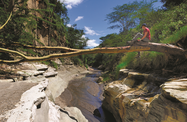Stronger brand recognition, an improved security climate and higher capacity are driving growth in Kenya’s meetings, incentives, conferences and exhibitions (MICE) tourism segment.
Kenya has seen a steady rise in MICE tourist arrivals over the past few years. In 2015 the country hosted 117,630 foreign arrivals taking part in MICE activities, representing a 13% increase on the 2014 total, and 15.6% of the total number of international tourist arrivals for the year.
To further boost the segment, in September Najib Balala, cabinet secretary for tourism, announced the formation of a special task force to establish a Kenya Convention Bureau, which would promote the country’s MICE segment. Currently, this is under the purview of the Kenyatta International Convention Centre (KICC) and the Kenya Tourism Board (KTB).
State of the tourism industry
The uptick is part of a welcome recovery in the tourism sector, which saw a slowdown last year on the back of a handful of high-profile terrorist incidents.
The first five months of this year saw a 14% increase in the number of inbound foreign visitors coming through Kenya’s two main air hubs, according to a report issued in August by the Kenya National Bureau of Statistics. Non-Kenyan arrivals at Jomo Kenyatta International Airport and Mombasa International Airport totalled more than 324,000 in the January to May period, a 40,000 year-on-year rise in foreign arrivals.
Revenue from tourism is also expanding, with sector earnings in the first half of this year totalling $470m, according to data released by Balala at the beginning of September. This puts the industry on track to generate year-end revenue of $1bn, as the peak tourism season was just opening, he told a meeting of industry representatives.
Government push
The government has launched a number of initiatives to help sustain the recovery and further drive MICE activity. According to press reports, for example, the budget for tourism marketing and promotion has more than doubled to $15m this year.
“Incoming conferences will be positive for tourism, and will also create confidence,” Jacinta Nzioka Mbithi, CEO of the KTB, told OBG. “Significant improvements have been made in terms of security, while media spending has also surged, which has helped perceptions.”
In light of the incidents in 2013 and 2015, improving safety and reducing crime and violence has also been a priority for the government, with the previous year’s budget having seen a 12% y-o-y increase to $2.5bn for security spending.
“Political stability and security remain a critical component of Kenya’s economic development. This is especially important to tourists, but also to business visitors travelling to the country. Kenya has responded robustly with police reforms and investment in the security sector, devolution of power to counties and pursuit of security at the regional level. Moreover, the increasing maturity of the country’s democratic process has reduced the risk of unrest before and during elections. Kenya is therefore poised for strong growth in both tourist numbers and foreign direct investment,” Moses M. Ikiara, managing director of KenInvest, told OBG.
Climbing the ranks
The improvements have led to Kenya’s greater recognition on the global level, with Nairobi named “Africa’s Leading Meetings and Conference Destination 2016” by the World Travel Awards in April, having been one of the runners up for each of the past three years.
However, it is not just Nairobi – which is home to the KICC – that is raising its MICE tourism profile, with other areas in Kenya also investing in developing conference-hosting capacity and hotels.
“There are several large new business and city hotels in Nairobi that will cater for the increased demand for MICE. Similarly, there are many resorts along the coast, which are providing for conference facilities as they develop their products,” Mbithi told OBG.
One such example is the Pride Inn Paradise Beach Resort and Convention Centre, located in Mombasa. Opened in March, the hotel aims to fill the gap in the beach tourism segment for resort conferencing. The resort has some 300 rooms and a convention centre, with capacity for 4500 delegates.
Another example of a resort-style hotel looking to capture the MICE segment is the Diani Reef Beach Resort and Spa. Located in Diani – which was awarded “Africa’s Leading Beach Destination” by World Travel Awards for three years in a row beginning in 2014 – the Diani Reef Beach Resort and Spa has recently revamped its conference facilities and now offers 160 sq meters of seating for 120 delegates.
Future bid
Kenya is also working to solicit new events to populate its growing conference venues.
To this end, in September Kenyan officials announced that the country would be bidding to host the 2018 global congress of SKAL, an international association of travel and tourism professionals. SKAL had been scheduled to hold its annual summit in Mombasa last year, but changed the venue in May over security concerns in the city.
Already this year, Kenya hosted three major international conferences: the UN Conference on Trade and Development 14, the Tokyo International Conference on African Development 6 and the Africa Green Revolution Forum 2016, while next year, Kenya has cemented its place as host to the Africa Health Agenda International Conference 2017, Power & Energy Kenya 2017, and the Oil, Gas & Mines Africa Exhibition and Conference.
Oxford Business Group is now on Instagram. Follow us here for news and stunning imagery from the more than 30 markets we cover.

